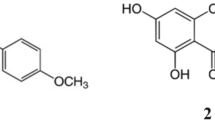Abstract
The rhizome of Polygonum cuspidatum is an important Chinese medicine used against infectious hepatitis, leucorrhagia, pruritus vulvae of the dampness-heat type, burns, snake bite, carbunculosis, amenorrhea, dysmenorrhea, trauma with blood stasis, and rheumatism, etc. Emodin, resveratrol, and polydatin are main active components of the rhizome. We report a simple densitometric HPTLC method for quantification of these compounds. The method was validated for precision, repeatability, and accuracy. The method was found to be precise, with RSD of 0.23, 0.25, and 0.32 (interday) and 0.45, 0.57, and 0.48 (intraday) for different concentrations of emodin, resveratrol, and polydatin, respectively. Instrument precision was 0.25, 0.23, and 0.34 (%CV) for emodin, resveratrol, and polydatin, respectively. The accuracy of the method was checked by measuring the recovery of the three compounds at three different levels; the average recoveries were 102.56%, 100.21%, and 100.27%, respectively. The amounts of emodin, resveratrol and polydatin in Polygonum cuspidatum, as estimated by the proposed method, were 4.96 mg g−1, 1.81 mg g−1, and 13.02 mg g−1. The HPTLC method proposed for estimation of emodin, resveratrol and polydatin was found to be simple, precise, specific, sensitive, and accurate and can be used for quality control of Polygonum cuspidatum.
Similar content being viewed by others
References
Yong-Qing Yan, Chuan-Long Yu, Tai-Kang Huang, Zhi-Zun Ding, Xuan-Liang Gao, Zhi-De Zhang (1996) The clinical application of Polygonum cuspidatum. In: Dictionary of traditional Chinese medicine, vol 2. China Science and Technology of Medicine Publisher, pp. 769
Yang F, Zhang T, Ito Y (2001) J Chromatogr A 919(2):443–448
Kong L-D, Cai Y, Huang W-W, Cheng C-H, Tan R-X (2000) J Ethnopharmacol 73(1/2):199–207
Pan M, Wang X (2000) Zhong Yao Cai 23(1):56–58
Chang C-J, Ashendel C-L, Geahlen R-L, McLaughlin J-L, et al. (1996) In-vivo 10(2):185–190
Manna SK, Ukhopadhyay A, Aggarwal BB (2000) J Immunol 164(12):6509–6519
Sato M, Maulik G, Bagchi D, Das DK (2000) Free Radic Res 32(2):135–144
Su H-Y, Cherng S-H, Chen C-C, Lee H (1995) Mutat Res 329(2):205–212
Kimura Y, Okuda H (2001) J Nutr 131(6):1844–1849
Zhao K-S, Jin C, Huang X, Liu J, Yan W-S, Huang Q, Kan W (2003) Clin Hemorheol Microcirc 29(3/4):211–217
Wang Dan, Tang Ying (1987) Chin Traditional Herbal Drugs 11:16
Yang F, Zhang T, Ito Y (2001) J Chromatogr A 919(2):443–448
Han Jin, Cai Guang-Ming (1996) Chin Pharm J 12:754
Acknowledgments.
This work is supported by the Natural Science Fund of Guangdong province Educational Bureau and University fund of Guangzhou University of Traditional Chinese Medicine.
Author information
Authors and Affiliations
Corresponding author
Rights and permissions
About this article
Cite this article
Zhao, Rz., Liu, S. & Zhou, Ll. Rapid Quantitative HPTLC Analysis, on One Plate, of Emodin, Resveratrol, and Polydatin in the Chinese Herb Polygonum cuspidatum. Chroma 61, 311–314 (2005). https://doi.org/10.1365/s10337-005-0514-y
Received:
Revised:
Accepted:
Published:
Issue Date:
DOI: https://doi.org/10.1365/s10337-005-0514-y




